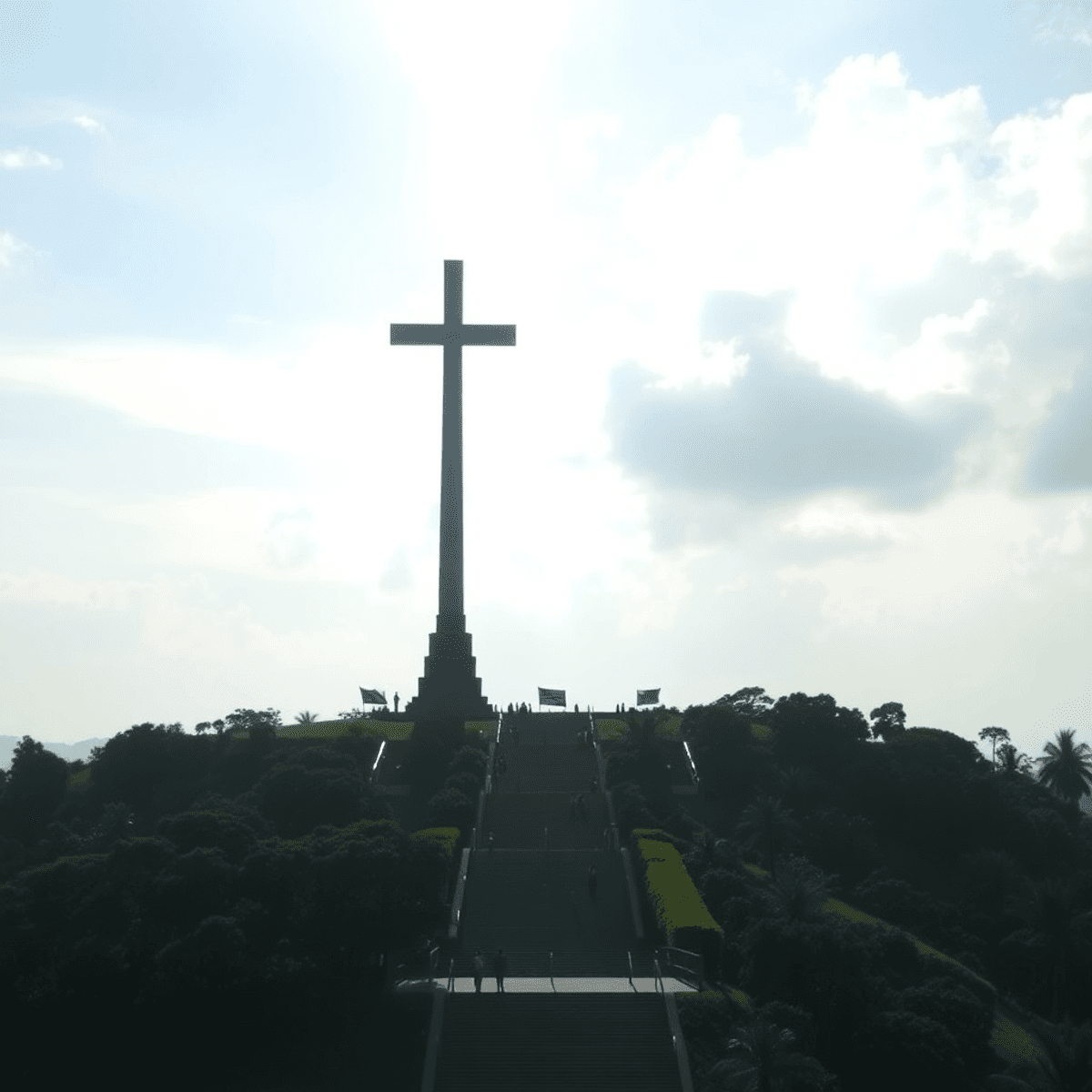
The Mt. Samat National Shrine is an important symbol of heroism and remembrance in Bataan’s history. It represents the bravery and sacrifices made during World War II, particularly the significant role Bataan played during that time.
With the upcoming redevelopment of the Mt. Samat Underground Museum, set to reopen in June, visitors will have a unique opportunity to explore Bataan’s legacy in a whole new way. The museum will feature advanced technologies such as virtual reality (VR) and holograms, bringing the history of Bataan to life in an immersive and unforgettable experience.
Whether you’re interested in Araw ng Kagitingan or World War II history, the Mt. Samat Underground Museum promises to offer a one-of-a-kind journey into the past.
The Mt. Samat Shrine in Pilar, Bataan, stands as a monumental tribute to the courage and sacrifice exhibited during one of the most pivotal chapters in Philippine history. Inaugurated on April 9, 1970, the shrine marks the anniversary of the fall of Bataan, symbolizing both remembrance and reverence for those who fought valiantly.
Bataan’s role extended beyond mere geography; it became a testament to heroism against overwhelming odds. The legacy preserved at Mt. Samat continues to inspire generations through its powerful symbolism and historical context rooted deeply in Filipino bravery.
The Philippines celebrates the Araw ng Kagitingan anniversary and Philippine Veterans Week with deep respect and gratitude, honoring the traditions of remembrance.
Araw ng Kagitingan, or Day of Valor, holds a special place in Philippine history as a day to honor the courage and sacrifice of Filipino heroes during World War II. It serves as a poignant reminder of the valor displayed by the defenders of Bataan, highlighting their unwavering spirit in the face of adversity.
To pay tribute to this significant day, various activities are organized, including the Parada ng Kagitingan float parade. This year, TIEZA – MS-FTEZ actively participated in this commemorative event, embodying the spirit of valor and heroism that defines the legacy of Bataan.
Embracing these moments of reflection and recognition, the nation stands united in honoring its brave veterans and celebrating their enduring legacy.
The Tourism Infrastructure and Enterprise Zone Authority (TIEZA) played a crucial role in redeveloping the Underground Museum at Mt. Samat as part of its initiative called the Mt. Samat Flagship Tourism Enterprise Zone (MS-FTEZ). This initiative aims to revitalize the museum and transform it into a modern heritage center that honors Bataan’s historical importance during World War II.
The museum has undergone an impressive transformation, evolving into a contemporary educational hub dedicated to preserving and showcasing the rich history of WWII in Bataan. With the use of immersive technology such as virtual reality (VR) and holograms, visitors will have the opportunity to experience a dynamic retelling of Bataan’s legacy, bringing historical events to life within the museum’s walls.
Scheduled to reopen this June, the Mt. Samat Underground Museum will offer public access to its state-of-the-art facility. Visitors can look forward to an engaging and enlightening journey through Bataan’s wartime past, making it an exciting destination for history enthusiasts and tourists alike.
The Mt. Samat Underground Museum uses virtual reality (VR) and augmented reality (AR) to create an immersive visitor experience that goes beyond traditional displays. These technologies transport visitors directly into the heart of World War II events, offering a vivid, first-person perspective of Bataan’s battlefield stories and heroic acts.
This combination of VR, AR, and holograms transforms static exhibits into dynamic learning experiences that honor Filipino valor while educating new generations about Bataan’s legacy.
The Mt. Samat Underground Museum features nine interconnected exhibit themes designed to immerse you deeply into the historical realities of Bataan during World War II. Each exhibit focuses on a distinct aspect of the conflict, emphasizing both the strategic importance and the human stories behind the battles.
This exhibit highlights the intense military engagements that defined Bataan’s role in the war. Authentic artifacts and detailed narratives transport you to the frontlines.
Personal stories spotlight Filipino and Allied soldiers who demonstrated extraordinary courage under dire circumstances.
Chronicles the surrender and its consequences, shedding light on pivotal moments that shaped Philippine history.
Celebrates acts of valor by soldiers and civilians alike, illustrating resilience amid hardship.
Other exhibits explore themes like strategic defense, medical efforts, and post-war remembrance. The original 1970 marker preserved here serves as a testament to lasting historical commitment. These displays combine to create a comprehensive tribute to Bataan’s battlefield legacy and its heroes’ sacrifices.
The Tourism Infrastructure and Enterprise Zone Authority (TIEZA) plays a crucial role in improving cultural tourism around the Mt. Samat Shrine area through its MS-FTEZ project. With the use of advanced technologies such as virtual reality (VR) and holograms, the Mt. Samat Underground Museum becomes more than just a tourist spot; it also serves as an invaluable educational resource for students, historians, and visitors.
This innovative approach not only safeguards Bataan’s history but also positions the region as a center for exploring historical sites and providing immersive learning experiences.
The innovative use of VR and holograms at the Mt. Samat Underground Museum breathes new life into the historical legacy of Bataan, offering a captivating experience for visitors.
Through these immersive technologies, efforts to honor the bravery and sacrifices of Filipino veterans and their families are elevated to new heights, ensuring their stories are preserved and celebrated for generations to come.
I encourage you to visit the reopened museum at Mt. Samat to immerse yourself in the rich history of Bataan, pay tribute to the heroes of the past, and gain a deeper understanding of the profound impact of World War II on the Philippines.

